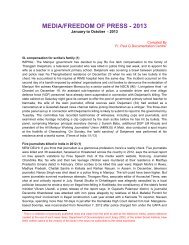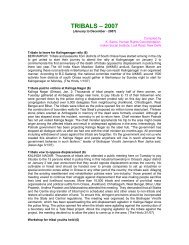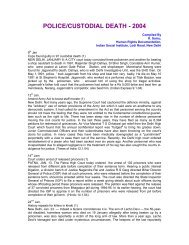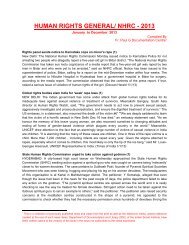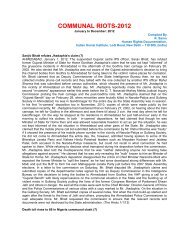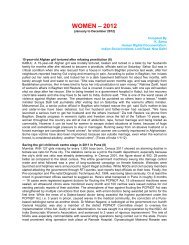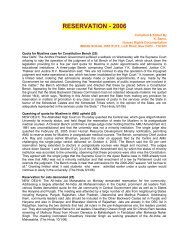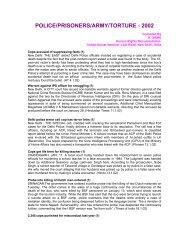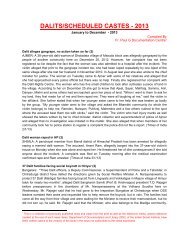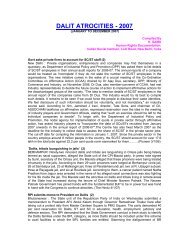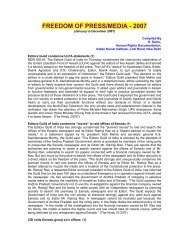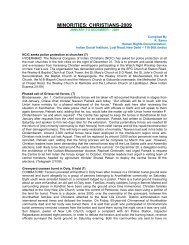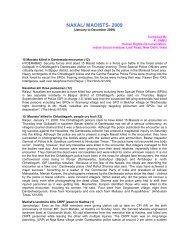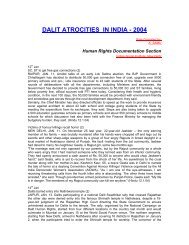You also want an ePaper? Increase the reach of your titles
YUMPU automatically turns print PDFs into web optimized ePapers that Google loves.
"The evolution of the tribes may be due to the initial penetration of the northern coastal areas of the <strong>Indian</strong><br />
Ocean by modern humans in their out of Africa migration. Therefore they are the windows to the look into<br />
the past and hence they need to be persevered," he said. (Statesman 17/5/055)<br />
<strong>Indian</strong> tribes linked to African ‘Eve’ (6)<br />
Hyderabad, India, May 19: Two primitive tribes in India's Andaman and Nicobar islands are believed to be<br />
direct descendants of the first humans who migrated from Africa at least 50,000 years ago, according to a<br />
study by <strong>Indian</strong> biologists. A team of biologists at the Centre for Cellular and Molecular Biology in<br />
Hyderabad studied the DNA of 10 Onge and Great Andamanese people in the <strong>Indian</strong> Ocean archipelago<br />
who lived for tens of thousands of years in "genetic isolation" from other human contact. The findings<br />
suggest the tribes are descended from the "oldest population of the world and were among the first batch<br />
of modern humans to migrate from Africa," said professor Lalji Singh, director of the centre. The tribals<br />
have similar physical features to Africans and their DNA suggests that they have close links with Africa.<br />
Mitochondrial DNA, which is passed maternally and found in every human cell, can be traced to a single<br />
female ancestor who lived about 150,000 to 200,000 years ago. It is believed the descendants of this<br />
"Eve" that all humans claim as their ancestor began migrating out of Africa in batches some 70,000 years<br />
ago. The tribals' DNA is extremely close to the so-called African root gene of the single female ancestor,<br />
Prof. Singh said this week. This made it likely that they migrated from Africa via a sea route 50,000 to<br />
70,000 years ago and have lived "in genetic isolation" since in the Andaman Islands, said Prof. Singh.<br />
(Asian Age 20/5/05)<br />
Tribals of Nicobar get new makeshift shelters (6)<br />
New Delhi: The Nicobarese tribals hit by the tsunami wave last December have made it to their new<br />
temporary shelters, beating the monsoon by a hair's breadth. All the 9,500 temporary shelters were ready<br />
in time for monsoon, which arrived last week. 98% of the refugees have moved into their new abodes.<br />
Those taking time to move are staying in vacant military barracks located on elevated ground. The one<br />
room-kitchen sets with toilets outside are precursors to permanent houses with residential quarters on the<br />
first floor and the ground floor reserved for cattle. But many refugees want the temporary shelters altered<br />
marginally and made permanent, since they are estimated to have a life of 10-15 years, official sources<br />
said. With these shelters in place, the first stage of relief and rehabilitation is over. The Andaman and<br />
Nicobar administration, supported by the Centre, is now embarking on an 18-month programme of<br />
repairing roads and jetties. Government has taken the stand that in view of security considerations on the<br />
islands, it would not receive any foreign fund nor allow any foreign agency to carry out the relief and<br />
rehabilitation tasks. After a phase of criticism at home and abroad, this point of view is better understood<br />
now. However, this places an added responsibility on the Centre that must fully fund the rehab task. This<br />
is being done in the form of compensation money that is already distributed through cheque payments.<br />
(Times of India 21/5/05)<br />
Tribals protest plan to oust them (6)<br />
NEW DELHI: A delegation of tribals under the aegis of Samajwadi Jan Parishad (SJP) arrived here on<br />
Tuesday to convey to the Chairman of the Prime Minister's Tiger Task Force, Sunita Narain, its intense<br />
dissatisfaction with the Government's reported move to relocate them.<br />
According to the delegation, there are plans to relocate up to 50 villages - accounting for some 4,000<br />
families — to create the Satpura Tiger Reserve, For a majority of the villagers, this is the second time they<br />
are being forced to relocate by government authorities. Just two decades ago many of those facing<br />
displacement now were forced to uproot themselves during the construction of the Tawa Reservoir.<br />
Questioning the logic of the relocation plan, the SJP spokesman, Sunil, stressed that the only way to<br />
preserve tigers was to recognise that Adivasis were not a threat to tigers. "After all tigers and Adivasis<br />
have lived side-by-'side for millennia," he said. Pointing the finger of blame at Forest Department officials,<br />
Mr. Sunil warned that "the Adivasis are the only ones who can contain the practices of a corrupt and<br />
irresponsible bureaucracy". Presenting evidence of such practices, a member of the delegation said<br />
resettlement of just one village had resulted in the felling of 50,000 trees in Dobjhirna forest —<br />
dramatically reducing the area available to tigers — and raised pressing questions about the<br />
environmental impact on the region if the Government goes ahead with its plan to move the other 49<br />
villages. Calling upon the Government to listen to the grassroots, the delegates noted that they had<br />
developed a "Cooperative Federation of Tribals" which had successfully coexisted with nature along the



